Pricing Guides & Dictionary of Makers Marks for Antiques & Collectibles

ANTIQUE AND COLLECTIBLE GINGER JARS
Join the most updated and complete collectibles research online - Learn more...
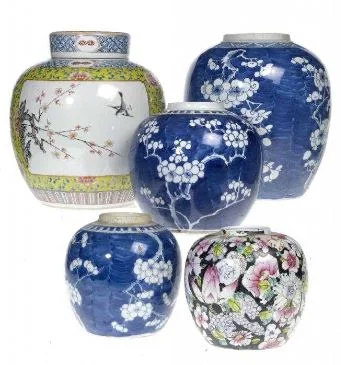 Ginger jars are a type of ceramic jar that originated in China during the Qin Dynasty (221 BC - 207 BC). These jars were originally used to store and transport various goods, including spices, tea, and ginger. Ginger jars are characterized by their rounded shape, wide mouth, and domed lid. They are often decorated with intricate designs and patterns.
Ginger jars are a type of ceramic jar that originated in China during the Qin Dynasty (221 BC - 207 BC). These jars were originally used to store and transport various goods, including spices, tea, and ginger. Ginger jars are characterized by their rounded shape, wide mouth, and domed lid. They are often decorated with intricate designs and patterns.
Today, antique and collectible ginger jars are highly sought after by collectors and enthusiasts all over the world. In this article, we will explore the history of ginger jars, their cultural significance, and how to identify and value them.
The History of Ginger Jars
Ginger jars have a long and rich history in China. They were originally used to store and transport goods, particularly spices and tea. The jars were often decorated with intricate designs and patterns, which were not only aesthetically pleasing but also served to identify the contents of the jar.
During the Ming Dynasty (1368-1644), ginger jars became increasingly popular as decorative objects. They were often used to display flowers, and the intricate designs and patterns were further refined. Ginger jars continued to be popular during the Qing Dynasty (1644-1911), and they were exported to other parts of the world, including Europe and the United States.
Today, antique ginger jars are highly prized by collectors and enthusiasts. They are often displayed as decorative objects, and their intricate designs and patterns are admired for their beauty and historical significance.
The Cultural Significance of Ginger Jars
Ginger jars have deep cultural significance in China. They are often associated with good luck and fortune, and they are frequently given as gifts during weddings, housewarmings, and other important occasions.
The designs and patterns on ginger jars are also significant. Many of them feature traditional Chinese motifs, such as dragons, phoenixes, and flowers. These motifs have deep cultural and symbolic meaning in Chinese culture, and they are often associated with prosperity, longevity, and good fortune.
Identifying and Valuing Ginger Jars
If you are interested in collecting antique ginger jars, it is important to know how to identify and value them. Here are some tips to help you get started:
- Look for markings - Many antique ginger jars will have markings on the bottom, which can help identify the manufacturer, date, and origin. Some of the most common markings include the reign mark of the emperor who was in power at the time the jar was made, as well as the name of the manufacturer or artist.
- Examine the design - The design of the ginger jar can also provide clues as to its age and origin. For example, jars with more intricate designs and patterns are generally older and more valuable than those with simpler designs.
- Check the condition - The condition of the ginger jar is also important in determining its value. Look for cracks, chips, and other damage, as these can significantly decrease the value of the jar.
- Consider the rarity - Finally, consider the rarity of the ginger jar. Jars that are one-of-a-kind or have unique designs are generally more valuable than those that are more common.
Conclusion
Antique and collectible ginger jars are not only beautiful decorative objects, but they also have deep cultural significance in China. If you are interested in collecting these jars, it is important to do your research and learn how to identify and value them. With their intricate designs, cultural significance, and historical value, antique ginger jars are a wonderful addition to any collection.
Unlock the true value of your collection with our comprehensive research guides from identifying makers' marks to appraising all kinds of antiques and collectibles, including items featured in this article.
Our up-to-date information will give you an accurate understanding of your items' worth. Don't miss out on this valuable resource - visit our research tools today!
In addition to some examples shown below on this page, you can also search our price guide for your own treasures.
Examples of related items from our Price Guides
-
 LOT OF 10 CHINESE AND JAPANESE GINGER JA
[more like this]
LOT OF 10 CHINESE AND JAPANESE GINGER JA
[more like this]
-
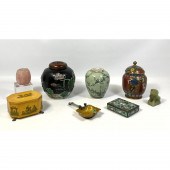 8pc Asian and Chinese Decorative Objects
[more like this]
8pc Asian and Chinese Decorative Objects
[more like this]
-
 ASIAN: CLOISONNé VASE, TWO GINGER JARS A
[more like this]
ASIAN: CLOISONNé VASE, TWO GINGER JARS A
[more like this]
-
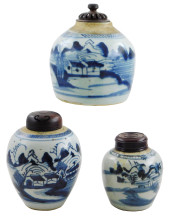 ASIAN: THREE CHINESE EXPORT GINGER JARS,
[more like this]
ASIAN: THREE CHINESE EXPORT GINGER JARS,
[more like this]
-
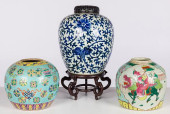 THREE CHINESE CERAMIC GINGER JARS<br>Pro
[more like this]
THREE CHINESE CERAMIC GINGER JARS<br>Pro
[more like this]
-
 LOT OF CHINESE PORCELAIN GINGER JARSLot
[more like this]
LOT OF CHINESE PORCELAIN GINGER JARSLot
[more like this]
-
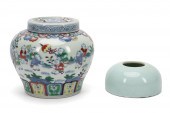 2PC CHINESE PORCELAIN, DOUCAI GINGER JAR
[more like this]
2PC CHINESE PORCELAIN, DOUCAI GINGER JAR
[more like this]
-
 CHINESE ROSE MEDALLION DECORATED PIERCED
[more like this]
CHINESE ROSE MEDALLION DECORATED PIERCED
[more like this]
-
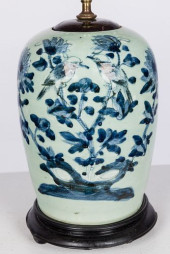 CHINESE BLUE AND WHITE GINGER JAR MOUNTE
[more like this]
CHINESE BLUE AND WHITE GINGER JAR MOUNTE
[more like this]
-
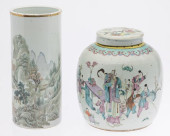 CHINESE GINGER JAR AND CYLINDER VASE<br>
[more like this]
CHINESE GINGER JAR AND CYLINDER VASE<br>
[more like this]
-
 Cosmopolitan Ginger Doll lot, 7 inch wal
[more like this]
Cosmopolitan Ginger Doll lot, 7 inch wal
[more like this]
-
 TWO CHINESE PORCELAIN GINGER JARS AND SW
[more like this]
TWO CHINESE PORCELAIN GINGER JARS AND SW
[more like this]
There are many more auction results available to our members...





